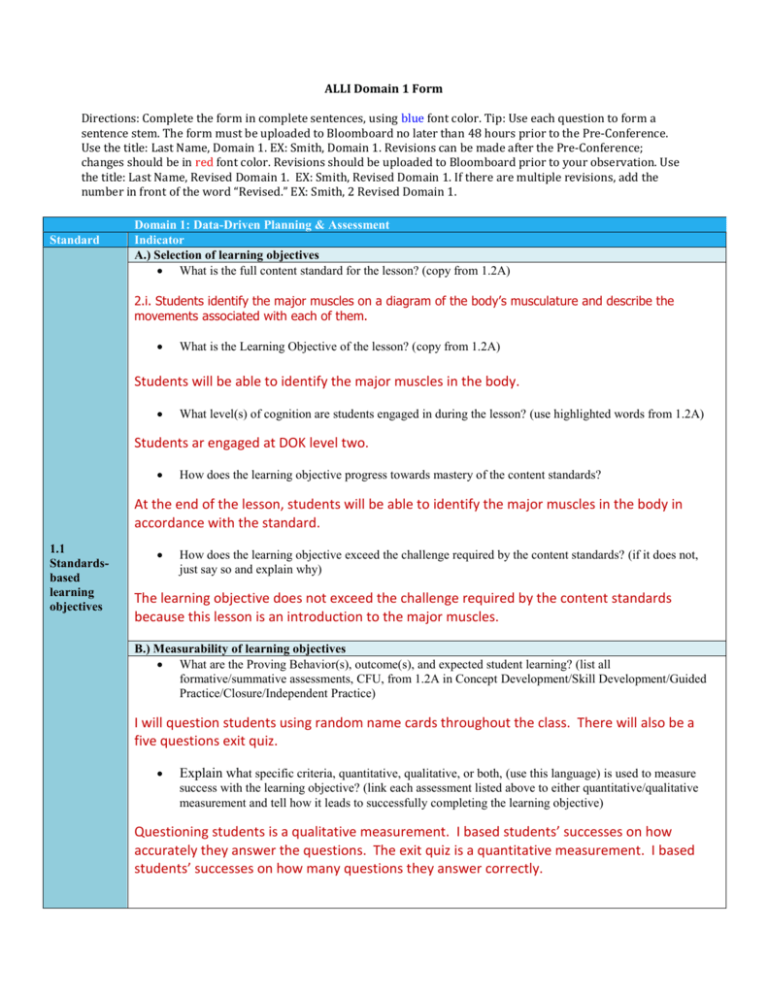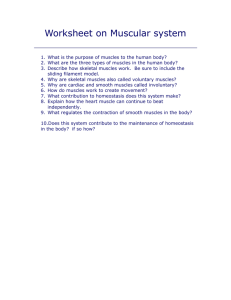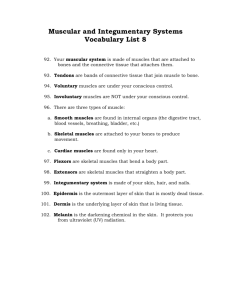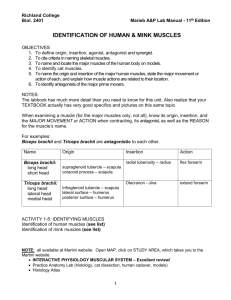ALLI Domain 1 Form Directions: Complete the form in complete
advertisement

ALLI Domain 1 Form Directions: Complete the form in complete sentences, using blue font color. Tip: Use each question to form a sentence stem. The form must be uploaded to Bloomboard no later than 48 hours prior to the Pre-Conference. Use the title: Last Name, Domain 1. EX: Smith, Domain 1. Revisions can be made after the Pre-Conference; changes should be in red font color. Revisions should be uploaded to Bloomboard prior to your observation. Use the title: Last Name, Revised Domain 1. EX: Smith, Revised Domain 1. If there are multiple revisions, add the number in front of the word “Revised.” EX: Smith, 2 Revised Domain 1. Standard Domain 1: Data-Driven Planning & Assessment Indicator A.) Selection of learning objectives What is the full content standard for the lesson? (copy from 1.2A) 2.i. Students identify the major muscles on a diagram of the body’s musculature and describe the movements associated with each of them. What is the Learning Objective of the lesson? (copy from 1.2A) Students will be able to identify the major muscles in the body. What level(s) of cognition are students engaged in during the lesson? (use highlighted words from 1.2A) Students ar engaged at DOK level two. How does the learning objective progress towards mastery of the content standards? At the end of the lesson, students will be able to identify the major muscles in the body in accordance with the standard. 1.1 Standardsbased learning objectives How does the learning objective exceed the challenge required by the content standards? (if it does not, just say so and explain why) The learning objective does not exceed the challenge required by the content standards because this lesson is an introduction to the major muscles. B.) Measurability of learning objectives What are the Proving Behavior(s), outcome(s), and expected student learning? (list all formative/summative assessments, CFU, from 1.2A in Concept Development/Skill Development/Guided Practice/Closure/Independent Practice) I will question students using random name cards throughout the class. There will also be a five questions exit quiz. Explain what specific criteria, quantitative, qualitative, or both, (use this language) is used to measure success with the learning objective? (link each assessment listed above to either quantitative/qualitative measurement and tell how it leads to successfully completing the learning objective) Questioning students is a qualitative measurement. I based students’ successes on how accurately they answer the questions. The exit quiz is a quantitative measurement. I based students’ successes on how many questions they answer correctly. A.) Design and sequence of learning experiences Be sure to include estimated time allocations for each bolded step. Highlight any cognitive level (DOK/Bloom’s) word used throughout the lesson plan. Content Standard (full): 2.i. Students identify the major muscles on a diagram of the body’s musculature and describe the movements associated with each of them. Learning Objective (An objective is three parts: Skill Level- measureable behavior/cognitive level, verb; Conceptmain idea, noun; Context- condition; “through” or “by”): Students will be able to identify the major muscles in the body. Activate Prior Knowledge: Students will answer twenty questions posted online using their laptops. (20 minutes) Lesson Importance (personal, academic, real-life- needs to be reiterated throughout the lesson): The muscular system is an important body system in students’ daily lives. 1.2 Organization of instructional plans Concept Development (how you are teaching the concepts from the LO) Concept(s) to teach: The major muscles are deltoid, pectoralis major, triceps brachii, biceps brachii, gluteus maximus. Definition of concept(s): Deltoid is muscle located in the shoulder. Pectoralis major is muscle located in the chest. Triceps brachii and biceps brachii are muscles located in the arms. Gluteus maximus is muscle located in the butt. Examples/Non-examples to use: Deltoid is located in the shoulder. Pectoralis major is located in the chest. Triceps brachii and biceps brachii are located in the arms. Gluteus maximus is located in the butt. Way(s) in which students will interact with the concept (take notes, pair share, read chorally, etc): Students will take notes in their science notebook using Cornell note format. (10 minutes) Students will also draw visual representations of their notes. (20 minutes) Students will then label the different muscles in the body. (30 minutes) What method of Checking for Understanding (CFU) will you use here? (Restate-Apply-Justify [RAJ] works really well for Concept Development) I will question students using random name cards throughout the lesson to check for understanding. I will monitor their learning by observing and helping students in the activity. Skill Level Development (how to execute the skill from the LO) Skill(s) to teach: Students will be able to identify major muscles in the body. Is this skill Declarative Knowledge (facts/information) or Procedural Knowledge (how to DO something)? Identifying is a declarative knowledge. If Declarative Knowledge: o What schema will you use to organize the details? (cause/effect, compare/contrast, main idea, sequential order, etc. Graphic organizer, note-taking?) I will use a diagram of the human body. o What modeling or demonstration pieces will be used? I will demonstrate how to label a muscle on the diagram. o What method will be used to help the students remember the information? Graphic organizer, note-taking, etc) Students will take notes in the notebook. o What method of Checking for Understanding (CFU) will you use here? (What/Why/How questions work really well for Skill Development) I will question students and monitor students’ progresses. If Procedural Knowledge: o What is the step-by-step process, method, or approach for the students to use? o Examples/Non-examples to use while modeling: o What method of Checking for Understanding (CFU) will you use here? (What/Why/How questions work really well for Skill Development) Guided Practice: What materials will be used? Students will be using laptops, notebooks, color pencils. What method(s) of CFU will you use here? (white boards, pair-share, thumb checks, etc) I will be questioning students using random name cards. I will occasionally do thumb checks. Closure: What question will you use to see that your students can correctly describe the content they just learned? Where is biceps brachii located? What question will you use to see that your students can tell you why the information they just learned is important? Why do you need muscles in the body? What question/problem will you use to have the students show they can successfully execute the skill they just learned? I will show a diagram of the body and have students point to the different muscles. Independent Practice: Students will be assigned a worksheet on the muscular system. (20 minutes) Students will also have a five questions exit quiz. (10 minutes) Homework: Students will write summary based on today’s notes in their notebook. B.) Create cognitively engaging learning experiences for students How does the Instructional Plan include cognitively engaging learning experiences throughout the lesson cycle? (use highlighted words from 1.2A) Students are identifying and labeling major muscles in the body diagram throughout the lesson. Students are operating at DOK level two. A.) Lesson design guided by data What types of student data are you using to inform your instruction? (Consider both formative and summative assessments- anything from BM/CST/unit exams, homework completion, tutoring needs, behavior, grouping, etc. Data is ANYTHING and EVERYTHING you consider when designing your lesson.) I question my students using random name cards. I also give my students exit quiz at the end of the class. Answer the following questions based on the above data: How are you using this data in order to select the instructional strategies for the lesson? Based on the formative assessment, I can decide whether to continue with direct instruction or move on to the next activity. 1.3 Student data How are you using this data to design the content organization of the lesson? Based on their performance on the summative assessment, I can decide whether I will revisit the topic of muscles the following class time. Who are the identified subgroups of students (Consider the following: ELL, RSP, high level, low level)? I have mostly ELL students. How are you using this data to select your group structure in the classroom? (observed in 3.3C) Because most of my students are ELL, I mostly select group at random making sure one person in each group has strong English skill. How are you using this data to meet the needs to EACH subgroup of students? Depending on how well students do, I can decide which words to put on my word wall and emphasize the following day for ELL students. A.) Knowledge of subject matter to identify pre-requisite knowledge What is the associated pre-requisite knowledge that students must have to be successful in this lesson? Students need to remember the important function of the muscular system. What skills do the students need in order to achieve the standard(s)/learning objective(s)? (copy from Skill Development in 1.2A) Students will be able to identify and label major muscles in the body. How will students be given the opportunity to activate prerequisite knowledge? (copy Activate Prior Knowledge from 1.2A) Students will answer twenty questions posted online using their laptops. What are any of the potential gaps in knowledge the students may have? (gaps= knowledge the students may not have because they either forgot it or were never taught it before; likely being taught in the Concept/Skill Development stages in 1.2A) Students may forget the important functions of the muscular system. 1.4 Subject matter content/skills and learning What strategies will be used to address any potential gaps for the whole group? I will include the important functions of the muscular system as part of the DO NOW questions. What strategies will be used to address any potential gaps for each sub-group? I will write the important words on the word wall for ELL students. B.) Addresses common content misconceptions What misconception(s) (misinterpretations) may students have related to this topic? Students may not be able to tell the difference between different muscles. What specific strategies will be used to ensure students recognize and address this misconception(s)? (list the strategies and explain how EACH will help address the misconception(s)) Students will be labeling the major muscles in the body diagram as an activity. This will reinforce the concepts of body muscles. A.) Selection and progression of formative assessments List each formative assessment from the lesson (found in 1.1B), and for EACH one, describe the data you received from it that helped lead the students toward mastery of the learning objective(s). I will question students using random name cards throughout the class. Depending on students’ responses, that will show me how well they master the learning objective. There will also be a five questions exit quiz. Depeding on students’ performances, that will show me how well they master the learning objective. List each formative assessment from the lesson (found in 1.1B), and for EACH one, describe the component of the lesson cycle that it accompanies. (all this info is in 1.2A) I will question students using random name cards throughout the class. This is throughout direct instruction and note taking. There will also be a five questions exit quiz. This is in the closure section near the end of class time. 1.5 Assessment Design List each formative assessment from the lesson (found in 1.1B), and for EACH one, describe how they show a progression toward student mastery of the lesson objective(s). I will question students using random name cards throughout the class. Students will be able to response more quickly and accurately as they show mastery of the lesson objective. There will also be a five questions exit quiz. Students will response more accurately as they show mastery of the lesson objective. B.) Planned response to assessment data List each formative assessment from the lesson (found in 1.1B), and for EACH one, describe how you might modify the lesson instruction based on the data you receive from it. (these are in the moment modifications) I will question students using random name cards throughout the class. Based on students’ responses, I can decide whether to spend more time with direct instruction or move on to the next activity. There will also be a five questions exit quiz. Based on students’ performance, I can decide whether to spend more time reviewing the topic. C.) Self-monitoring List the opportunity (ies) students will have to monitor their own learning during the lesson? Students will have an opportunity to monitor their own learning as they are answering questions in the DO NOW portion. Students will also have addition opportunity to monitor their own learning as they work with a partner during the activity. How will their self-monitoring move students toward deeper mastery of the objective(s)? When students realize they do not remember how to answer questions in the DO NOW, it will remind them to study more to master the objective. When they realize that they are not contributing to the activity, it will remind them to study more to master the objective.






